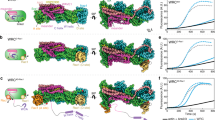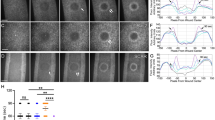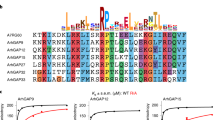Abstract
WAVE-1, which is also known as Scar, is a scaffolding protein that directs actin reorganization by relaying signals from the GTPase Rac to the Arp2/3 complex. Although the molecular details of WAVE activation by Rac have been described, the mechanisms by which these signals are terminated remain unknown. Here we have used tandem mass spectrometry to identify previously unknown components of the WAVE signalling network including WRP, a Rac-selective GTPase-activating protein. WRP binds directly to WAVE-1 through its Src homology domain 3 and specifically inhibits Rac function in vivo. Thus, we propose that WRP is a binding partner of WAVE-1 that functions as a signal termination factor for Rac.
This is a preview of subscription content, access via your institution
Access options
Subscribe to this journal
Receive 12 print issues and online access
$209.00 per year
only $17.42 per issue
Buy this article
- Purchase on Springer Link
- Instant access to full article PDF
Prices may be subject to local taxes which are calculated during checkout



Similar content being viewed by others
References
Hall, A. Science 279, 509–514 (1998).
Adams, A. E. & Pringle, J. R. J. Cell Biol. 98, 934–945 (1984).
Mullins, R. D. Curr. Opin. Cell Biol. 12, 91–96 (2000).
Machesky, L. M. & Insall, R. H. Curr. Biol. 8, 1347–1356 (1998).
Takenawa, T. & Miki, H. J. Cell Sci. 114, 1801–1809 (2001).
Bear, J. E., Krause, M. & Gertler, F. B. Curr. Opin. Cell Biol. 13, 158–166 (2001).
Welch, M. D. Trends Cell Biol. 9, 423–427 (1999).
Higgs, H. N. & Pollard, T. D. Annu. Rev. Biochem. 70, 649–676 (2001).
Westphal, R. S., Soderling, S. H., Alto, N. M., Langeberg, L. K. & Scott, J. D. EMBO J. 19, 4589–4600 (2000).
Miki, H., Suetsugu, S. & Takenawa, T. EMBO J. 17, 6932–6941 (1998).
Miki, H., Yamaguchi, H., Suetsugu, S. & Takenawa, T. Nature 408, 732–735 (2000).
Chin, L. S., Nugent, R. D., Raynor, M. C., Vavalle, J. P. & Li, L. J. Biol. Chem. 275, 1191–1200 (2000).
Stradal, T. et al. Curr. Biol. 11, 891–895 (2001).
Scita, G. et al. Nature 401, 290–293 (1999).
Erpel, T., Superti-Furga, G. & Courtneidge, S. A. EMBO J. 14, 963–975 (1995).
Rickles, R. J. et al. EMBO J. 13, 5598–5604 (1994).
Rittinger, K. et al. Nature 388, 693–697 (1997).
Boguski, M. S. & McCormick, F. Nature 366, 643–654 (1993).
Luo, L., Jan, L. & Jan, Y. N. Perspect. Dev. Neurobiol. 4, 199–204 (1996).
Luo, L., Jan, L. Y. & Jan, Y. N. Curr. Opin. Neurobiol. 7, 81–86 (1997).
Hussain, N. K. et al. Nature Cell Biol. 3, 927–932 (2001).
Eden, S., Rohatgi, R., Podtelejnikov, A. V., Mann, M. & Kirschner, M. W. Nature 418, 790–793 (2002).
Shevchenko, A., Wilm, M., Vorm, O. & Mann, M. Anal. Chem. 68, 850–858 (1996).
Frank, R. & Overwin, H. Methods Mol. Biol. 66, 149–169 (1996).
Self, A. J. & Hall, A. Methods Enzymol. 256, 67–76 (1995).
Acknowledgements
We thank L. Langeberg for help preparing the manuscript; R. Mouton for technical assistance; C. S. Boone and M. Evangelista for sharing unpublished data and for critical review of the manuscript; and T. R. Soderling for support. This work was supported by grants from the National Institutes of Health, the Canadian Institutes of Health Research (CIHR), the National Cancer Institute of Canada (NCIC) and the Ontario R&D Challenge Fund (J.D.S., T.P. & G.A.W.). T.P. is a CIHR Distinguished Scientist. K.L.B. is supported by a National Science and Engineering Research Council of Canada (NSERC)/MDS-Sciex Industrial Postgraduate Scholarship. S.H.O. is supported by a postdoctoral fellowship from the National Medical Research Council of Singapore.
Author information
Authors and Affiliations
Corresponding author
Ethics declarations
Competing interests
The authors declare no competing financial interests.
Supplementary information
Supplementary figures and methods
Figure S1. Immunocytochemical experiments were performed to confirm the mass spectrometry and biochemical data and assess the cellular distribution of WRP and WAVE. (PDF 300 kb)
Figure S2. HEK293 cells were transfected with WRP or WRPGAP and Rac-GTP levels were measured by the Pak-1 capture assay.
Supplementary Methods
Rights and permissions
About this article
Cite this article
Soderling, S., Binns, K., Wayman, G. et al. The WRP component of the WAVE-1 complex attenuates Rac-mediated signalling. Nat Cell Biol 4, 970–975 (2002). https://doi.org/10.1038/ncb886
Received:
Revised:
Accepted:
Published:
Issue Date:
DOI: https://doi.org/10.1038/ncb886
This article is cited by
-
Electroacupuncture inhibits dendritic spine remodeling through the srGAP3-Rac1 signaling pathway in rats with SNL
Biological Research (2023)
-
Optogenetic dissection of Rac1 and Cdc42 gradient shaping
Nature Communications (2018)
-
SRGAP1, a crucial target of miR-340 and miR-124, functions as a potential oncogene in gastric tumorigenesis
Oncogene (2018)
-
F-BAR family proteins, emerging regulators for cell membrane dynamic changes—from structure to human diseases
Journal of Hematology & Oncology (2015)
-
APP intracellular domain–WAVE1 pathway reduces amyloid-β production
Nature Medicine (2015)



